Quick Start for HVR - HDFS
This quick start guide helps you to get started with HVR for replicating data into Hadoop Distributed File System (HDFS).
To proceed with this replication you must have basic understanding about HVR's architecture and terminologies like Hub, Location, Channel, Location Groups, Actions etc.
The example here demonstrates how to replicate tables from one Oracle schema (source location) to HDFS (target location).
Before proceeding with this example ensure that the requirements for using HVR with Oracle and Greenplum are met.
For information about access privileges and advanced configuration changes required for performing replication using Oracle and HDFS, see:
Create Test Schema and Tables
Create Source Schema
create user sourcedb identified by hvr default tablespace users temporary tablespace temp quota unlimited on users;
Create Tables in Source Schema
create table sourcedb.dm51_product ( prod_id number(10) not null, prod_price number(10,2) not null, prod_descrip varchar2(100) not null, primary key (prod_id) );
create table sourcedb.dm51_order ( prod_id number(10) not null, ord_id number(10) not null, cust_name varchar2(100) not null, cust_addr varchar2(100), primary key (prod_id, ord_id) );
Insert Values in Source Tables
insert into sourcedb.dm51_product values (100, 90, 'Book');
insert into sourcedb.dm51_order values (100, 123, 'Customer1', 'P.O. Box 122, Anytown, Anycountry');
Install HVR on the hub
An HVR distribution is available for download at the Fivetran.com website. For more information, see Downloading HVR.
Install HVR on a hub machine. For details on installing HVR, see the respective operating system sections:
The HVR distribution requires a license key in order for the software to operate. Please see the HVR licensing page for more details on how to install the HVR license.
After the installation, you can control HVR using the HVR graphical user interface (HVR GUI).
- If the hub machine is Windows, then HVR GUI can be executed directly on the hub machine.
- To control HVR remotely from your PC, connect to the hub machine using Windows Remote Desktop Connection and launch HVR GUI on the hub machine.
- If the hub machine is Linux, then HVR GUI can be executed directly on the hub machine. However, an application like X Server or VNC viewer must be installed to run HVR GUI directly on Linux.
- To control HVR remotely from your PC, install HVR on the PC (with Windows or macOS) and configure the HVR Remote Listener on the hub machine.
- If the hub machine is Unix, then HVR GUI should typically be run remotely from a PC to control HVR installed on the hub machine. To do this, install HVR on the PC (with Windows or macOS) and configure the HVR Remote Listener on the hub machine.
The HVR Remote Listener allows you to connect HVR GUI available on your PC to the remote HVR hub machine. For more information about connecting to remote HVR installation, see Configuring Remote Installation of HVR on Unix or Linux and Configuring Remote Installation of HVR on Windows.
Install HVR to connect to Hadoop
First read section Architecture Overview which explains the HVR's terminology and architecture. In particular this explains the importance of a hub database.
In order to connect to Hadoop as a target HVR must be running on a Linux environment. This can be the HVR hub running on Linux, or HVR can be running as an agent on a Linux server to connect into HDFS, optionally on the Hadoop namenode. The HDFS interface requires a Java 7 Runtime Environment and Hadoop connectivity libraries.
Install the HVR software on the Linux machine by following the installation steps in section Installing HVR on Unix or Linux.
Follow the steps in Requirements for HDFS
for the Java Runtime environment and the Hadoop connectivity libraries.
Create the Hub Database
This section describes how to create a hub database (schema). The hub database is a repository database that HVR uses to control its replication activities. It contains HVR catalog tables that hold all specifications of replication such as the names of the replicated databases, the replication direction and the list of tables to be replicated. For more information about HVR hub server and database, see section Hub Server in System Requirements.
HVR supports the creation of a hub database on certain databases (location classes) only. For the list of supported location classes, see section Hub Database in Capabilities.
For this demonstration, the hub database (e.g. hvrhub) is created in Oracle.
Create the hub database (hvrhub) with password (hvr).
create user hvrhub identified by hvr default tablespace users temporary tablespace temp quota unlimited on users;
Connect To Hub Database
This section describes how to connect HVR GUI to the hub database.
When you launch HVR GUI for the first time, the Register Hub dialog is displayed automatically. The Register Hub dialog can also be accessed from menu File by selecting Register Hub. Skip steps 1 to 4 if you want to run HVR GUI directly on the hub machine.
Click Connect to HVR on remote machine.
To connect HVR GUI on a PC to a remote HVR hub machine, the HVR Remote Listener must be configured and running on the HVR hub machine.
Enter the name or IP address of the hub machine in the Node field (e.g. myserver).
Enter the port number (defined in the HVR Remote Listener of the hub machine) in the Port field (e.g. 4343).
Enter the Login (e.g. myserveradmin) and Password for the hub machine. By default, this is the operating system login credentials of the hub machine.
Select Oracle in the Class pane.
Specify Database Connection details.
- Enter the directory path in ORACLE_HOME. You can also click the browse button to select the directory path.
- Enter the Oracle System ID in ORACLE_SID or TNS credentials.
- Enter the user name of the hub database in User (e.g. hvrhub).
- Enter the password for the hub database in Password (e.g. hvr).
Click Connect.

Click Yes in the prompt dialog asking to create catalog tables in the hub database.
HVR displays this prompt when connecting to a hub database for the first time.
On connecting successfully to the hub database, the navigation tree pane displays the hub machine and the hub database. Location Configuration, Channel Definitions, and Scheduler are displayed under the hub database.
Create Oracle Location
- In navigation tree pane, right-click Location Configuration ▶ New Location.
- Enter Location name and Description for the location.
- Select Oracle in Class.
- Provide Database Connection details. For more information on Database Connection fields, see section Location Connection.
Enter directory path for ORACLE_HOME. You can also click browse to select directory path.
Enter Oracle System ID in ORACLE_SID or TNS credential or RAC credential.
For RAC connectivity, ensure to provide remote machine connection details under Connection tab.
Enter user name of schema in User. For example, sourcedb.
Enter password for schema in Password. For example, hvr.
- Click Test Connection to verify the connection to location database.
- Click OK.
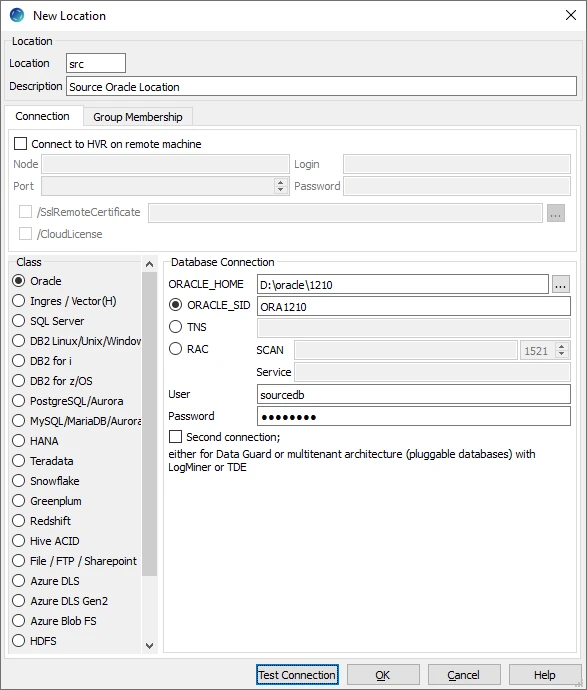
Create HDFS Location
Create a location for HDFS using right-click on Location Configuration ▶ New Location.

In this example Connect to HVR on remote machine is checked assuming this Linux environment is not the hub machine. If it is then it must not be checked.
Ignore the Group Membership tab for now.
In order to connect to a Hadoop cluster with Kerberos authentication, you can consult HDFS Authentication and Kerberos.
Create a Channel
This section describes how to create a channel in HVR. A channel groups together the locations and tables that are required for replication. It also contains actions that control how replication should be done.
- In navigation tree pane, right-click Channel Definitions ▶ New Channel.
- Enter Channel name and Description for the channel in New Channel dialog.
- Click OK.
Create Location Groups
This section describes how to create location groups in a channel. The location groups are used for defining action on the location. Typically a channel contains two location groups - one for the source location and one for the target location. Each location group can contain multiple locations.
In this example, create one source location group (OLTP) and one target location group (DATALAKE).
- In navigation tree pane, click + next to the channel (hvrdemo).
- Create source location group (OLTP):
- Right-click Location Groups ▶ New Group.
- Enter Group Name and Description for the location group.
- Select source location (db1) from Group Membership.
- Click OK.
- Create target location group (DATALAKE):
- Right-click Location Groups ▶ New Group.
- Enter Group Name and Description for the location group.
- Select target location (hdfs) from Group Membership.
- Click OK.
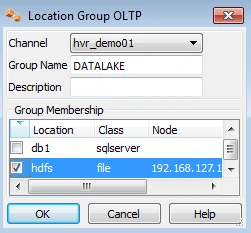
Select Table(s)
This section describes how to select the tables from source location for replication. Table Explore allows you to select schema(s) and/or table(s) for replication.
- Right-click Tables ▶ Table Explore.
- Select source location (db1) from the list.
- Click Connect.
- Select tables from Table Explore dialog. Press Shift key to select multiple tables or Ctrl+A to select all tables.
- Click Add to add the selected tables.
- Click OK in HVR Table Name dialog.
- Click Close in Table Explore dialog.
Define Actions
The new channel needs actions to define the replication.
- Right-click on group OLTP ▶ New Action ▶ Capture.
- Right-click on Group DATALAKE ▶ New Action ▶ FileFormat. Select parameter /Csv, and optionally specify arguments to change the format of the output file.
- Right-click on Group DATALAKE ▶ New Action ▶ Integrate. Check /RenameExpression, and put in /{hvr_tbl_name}/{hvr_integ_tstamp}.csv to create new files for every integrate cycle. Also add ColumnProperties /Name=hvr_op_val /Extra /IntegrateExpression={hvr_op} /TimeKey to include the operation type per record (0 for delete, 1 for insert, 2 for update). For a very busy system check the option /Burst to combine multiple transactions into one (larger) file per table.
- Right–click on Group DATALAKE ▶ New Action ▶ Scheduling. Check /IntegrateStartTimes, and select from the calendar. For example, for a 10-minute refresh interval starting at the top of the hour check multiples of 10 for resulting *RefreshStartTimes /0,10,20,30,40,50 * * * **.
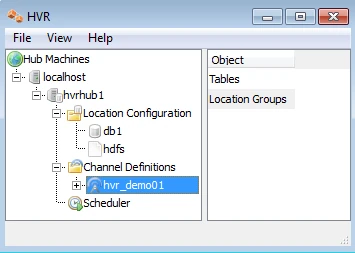
The Actions pane only displays actions related to the objects selected in the left–hand pane. So click on channel hvr_demo01 to see both actions.
Enable Replication with HVR Initialize
Now that the channel definition is complete, create the runtime replication system.
Right–click on channel hvr_demo01 ▶ HVR Initialize. Choose Create or Replace Objects and click HVR Initialize.

From the moment that HVR Initialize is done, all new transactions that start on the database testdb1 will be captured by HVR when its capture job looks inside the transaction logs.
HVR Initialize also creates two replication jobs, which can be seen under the Scheduler node in the GUI.
Start Scheduling of Capture Job
Start the Scheduler on the hub machine by clicking in the HVR GUI on the Scheduler node of the hub database.
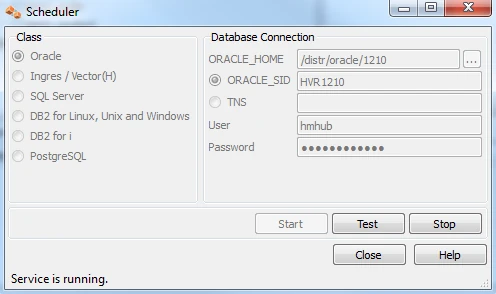
Next, instruct the HVR Scheduler to trigger the capture job to keep the capture job current with transaction log generation.
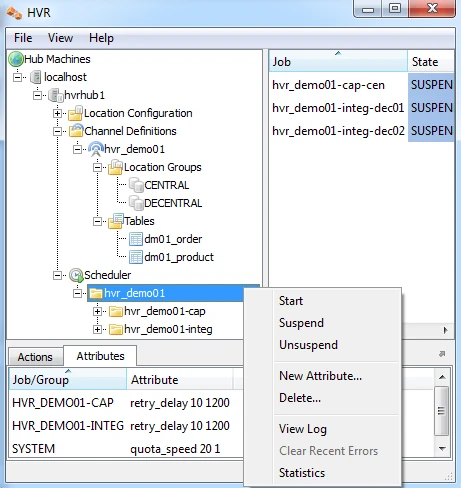
The capture job inside the Scheduler executes a script under $HVR_CONFIG/job/hvrhub/hvr_demo01 that has the same name as the job. So job hvr_demo01–cap–db1 detects changes on database testdb1 and stores these as transactions files on the hub machine.
Perform Initial Load
Perform the initial load from the OLTP database into HDFS using HVR Refresh. Right-click on the channel hvr_demo01 ▶ HVR Refresh.
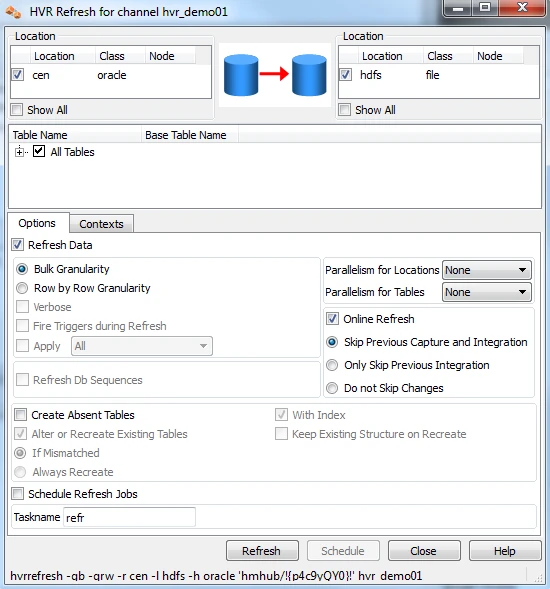
Make sure the option for Online Refresh is checked and select Skip Previous Capture and Integration. Optionally set Parallelism for Tables.
Run the Refresh.
Start Scheduling of Capture Job
Instruct the HVR Scheduler to Unsuspend the integrate job to push changes into HDFS according to the defined schedule.
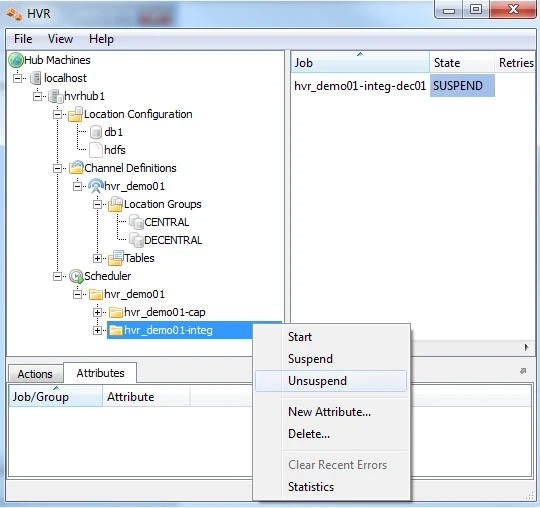
The integrate job inside the Scheduler executes a script under $HVR_CONFIG/job/hvrhub/hvr_demo01 that has the same name as the job. So job hvr_demo01–integ-hdfs picks up transaction files on the hub on a defined schedule and creates files on HDFS containing these changes.
A scheduled job that is not running is in a PENDING state.
Test Replication
To test replication, make a change in testdb1:
testdb1/hvr SQL> insert into dm01_product values (1, 19.99, 'DVD'); SQL> commit;
Next, instruct the HVR Scheduler to Trigger the integrate job rather than wait for the next scheduled run.
In the HVR log file you can see the output of the jobs by clicking on View Log. This log file can be found in $HVR_CONFIG/log/hubdb/hvr.out.

The job output looks like this:
hvr_demo01-cap-db1: Scanned 1 transaction containing 1 row (1 ins) for 1 table. hvr_demo01-cap-db1: Routed 215 bytes (compression=40.6%) from 'db1' into 2 locations. hvr_demo01-cap-db1: Capture cycle 3. hvr_demo01-integ-hdfs: Integrate cycle 1 for 1 transaction file (215 bytes). hvr_demo01-integ-hdfs: Moved 1 file to 'hdfs://cloudera@192.168.127.128/user/hvr'. hvr_demo01-integ-hdfs: Processed 1 expired 'trigger' control file. hvr_demo01-integ-hdfs: Finished. (elapsed=4.04s)
This indicates that the jobs replicated the original change to HDFS. A query on HDFS confirms this:
[cloudera@quickstart ~]$ hadoop fs -ls /user/hvr Found 2 items drwxr-xr-x - cloudera supergroup 0 2015-02-06 10:38 /user/hvr/_hvr_state -rw-r--r-- 3 cloudera supergroup 12 2015-02-06 10:38 /user/hvr/dm01_product_20150206183858632.csv [cloudera@quickstart ~]$ hadoop fs -cat /user/hvr/dm01_product_20150206183858632.csv
1,19.99,DVD [cloudera@quickstart ~]$